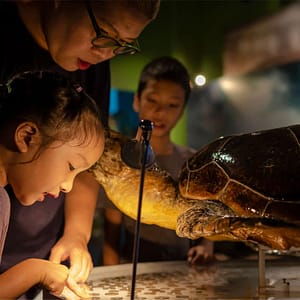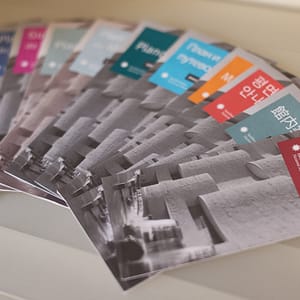How Translation Helps Museums Promote Intergenerational Learning
Museums everywhere embrace their role as educator, with many making it part of their mission to inspire and excite learners of all ages. A key part of this imperative is making learning opportunities accessible to all—people from different communities, socio-economic backgrounds, and cultures. Today, as family structures continue to evolve and society becomes increasingly linguistically diverse, museums find more and more opportunities to make learning accessible to young and old. In this article, we explore the ways museums can create the tools and resources that facilitate learning—across generations and languages.
Family Visits Create Lifelong Museumgoers
Education doesn’t just happen in the classroom. It happens while doing—through experiences that are meaningful, authentic, and memorable. Museums have the ability to facilitate such learning opportunities by exposing visitors to new information and different points of view in environments that are engaging, stimulating, and interactive.
Children are the future of any museum, and there are different ways to get them engaged. Field trips are one. But family visits are a little different—they offer a special opportunity for members of a family to have fun together. Museums are spaces in which families spend quality time outside of school. Kids enjoy exhibits with their family members, sparking questions, observations, and debate.
The Smithsonian conducted a survey of their visitors that sheds some light on the way family visits impact future behavior. Among the adult visitors surveyed, approximately one third (32%) said they had visited the Smithsonian before age 18. Of those, one fifth (19%) had come with their parents or relatives, 8% had been a part of a school group, and 5% had come with both their parents and a school group. Half of all adult repeat visitors who had visited with their family before age 18 were visiting now with children.1
It shouldn’t come as a surprise that children who enjoy a museum with their families are more likely to frequent that museum as adults. And it’s not only the children who benefit—parents, grandparents, and family members of all ages explore and learn side by side. When parents bring their children to a museum, it helps instill a strong sense of appreciation that can turn a kid into a lifelong museum-goer.
How Museums Facilitate Intergenerational Learning
Museums understand the value of this experiential learning, and offer a wide variety of programs that allow adults to learn alongside children:
- Family activity classes or workshops
- Storytime
- Family tours
- Family days (mornings, or afternoons)
- Discovery rooms (corners or tables) featuring activities, books, or other hands-on opportunities for family learning
- Art-making sessions
- Films
- Family outreach workshops, held in libraries, community centers, or churches
Some of the methods museums have used in the past may benefit from rethinking as family structures evolve, communities diversify, and new delivery methods become available.
Bilingual Families
Family life is changing. In the U.S., two-parent households are on the decline. In fact, there is no longer one dominant family form. Expanded families encompass stepfamilies, single parents, grandparents as primary caregivers, and many other varieties of blended families. As family structures continue to change and expand, so does the way language is spoken in a family, across generations.
We live in a multilingual society. Today, more than 350 different languages are spoken all across the United States. After English, Spanish strongly holds the title of the second most widely spoken language in the country, followed by Chinese, Tagalog, Vietnamese, French, Korean, and German. While the number of people in the U.S. who speak a language other than English at home is growing, the levels of proficiency vary across generations.
As immigrants have children, the familiarity with the mother tongue often declines generation over generation. As an example, consider these statistics regarding U.S. Spanish-speaking families. While 61% of Hispanic immigrants in the U.S. are Spanish-dominant (and another 32% are bilingual), the share who are Spanish-dominant drops to 6% among second-generation Hispanics and to less than 1% among third- or higher generation Hispanics. These disparities speak to significant differences in linguistic proficiency among members of a single extended family.2
Let’s Chat!
Get in touch to speak with a member of our team.
The Importance of Translation in Education to Support Intergenerational Learning
The tools museums use to engage visitors are evolving. Interactive elements enable museums to offer new, enhanced, interactive learning environments—something for all ages. But people will always elect to participate in those activities best suited to their needs, and without significant obstacles. This immediacy makes it important to provide learning experiences that can be understood by all age groups, across cultural and language barriers.
Translation gives people of different ages and linguistic ability the opportunity to comprehend and interact with learning activities. That way, all family members feel comfortable and no one is relegated to the sidelines because they don’t understand the language.
Making Exhibits Accessible to All Generations
A 13-year-old who is comfortable speaking English might attend a museum accompanied by her bilingual older sister. They could be joined by their mother (who is more comfortable with Spanish than English) and grandmother with limited English ability. An exhibit with labels in both Spanish and English allows the entire family to understand the content, in the language in which each feels most comfortable. Translating exhibition didactics makes them accessible to all generations of a family with varying degrees of language fluency. No one is left out, and all members of the family are able to discuss the subject with each other.
From printed handouts, to hands-on activity instructions, or interactive touch screens, the educational resources museums produce to enhance learning experiences are varied. Translating some or any of these items makes supplemental learning materials available across languages, across generations.
Time, budget, staff, and space will always be obstacles. But the translation of museum materials is scalable. An institution might start by translating a single, popular exhibit into the language most common to the local area. It could make weekly art workshops available in both English and Spanish or translate children’s activity sheets into the top five languages (or more!) spoken by museum visitors.
Some Notable Museums With Multilingual Exhibits
There are many great examples of museums making their exhibits friendly to all generations of non-English speaking visitors. California Academy of Sciences, a world-class scientific and educational institution in San Francisco, is committed to expanding environmental literacy. To make their new interactive exhibits, Giants of Land and Sea and Skin, accessible to local communities, the Academy translated all exhibit materials into Spanish, Traditional Chinese, and Filipino. When the South Florida Science Center developed the world’s most advanced exhibit on the human brain, they translated all of Journey Through the Human Brain’s high-tech displays, immersives, and interactives into Spanish.
Translating audio guides is another way museums help intergenerational visitors interact with exhibits. Audio tours enable families to engage with exhibits together or independently, at their own pace, in the language of their choice. And audio guide translation is also flexible. Many museums begin by translating audio tours for key selections of works within their permanent collection. Audio guides can then be easily expanded to create kid- or family-friendly versions. One recent example of a family-friendly audio tour is the newly revamped Ellis Island tour. Acoustiguide, in collaboration with the National Park Service and The Statue of Liberty-Ellis Island Foundation, developed a compelling, multigenerational, multilingual experience for kids and their families. This video, by News 12 New Jersey, captures a few of the reactions expressed by students and parents after their visit to the historic site.
Featured Services
Learn more about…
Positive Responses to Translated Content
Numerous studies have looked at the impact translated materials have on museum visitors. The Smithsonian National Museum of American History surveyed second-generation Latino visitors. Even though many Latino museum visitors in this study were English-speaking, they still appreciated bilingual signs as “signals” that museums are inclusive and welcoming to immigrant families and non-English speakers.3
In 2019, the Brooklyn Museum launched the blockbuster show Frida Kahlo: Appearances Can Be Deceiving, for which they translated exhibition didactics, ticketing pages, signage, floor plans, and even quotes from the artist displayed as teasers throughout the museum. A study was conducted to analyze the impact of the museum’s decision to translate. Results found that “Visitors responded positively to the inclusion of Spanish-language materials, particularly the exhibition labels, whether or not they used them personally, and indicated that continued inclusion of bilingual materials would make them more likely to make a return visit to the museum.”4
Memorable, Immersive Experiences for the Whole Family
Museums provide memorable and immersive experiences for kids, quality time for families, and many unique opportunities for self-directed, hands-on learning. To encourage participation from all people, across cultural backgrounds, consider the role language plays for visitors young and old. Translation is one relatively easy, scalable way museums can enhance their role as facilitators of intergenerational learning.
 Named to the 2024 Inc. 5000 list of fastest-growing companies and ranked among the world’s top 100 language service providers by CSA Research
Named to the 2024 Inc. 5000 list of fastest-growing companies and ranked among the world’s top 100 language service providers by CSA Research

